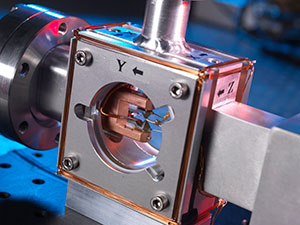NPL is carrying out leading-edge optical clock research to achieve fractional frequency uncertainties of 1 part in 1018. This is approximately two orders of magnitude better than the current caesium microwave primary standards. We are also developing compact and portable systems, to support a range of quantum technologies that will enable precision measurements beyond the laboratory environment.
Optical atomic clocks have many potential applications. These include quantum sensing, synchronisation of high-speed networks, space science and tests of fundamental physical theories. In future, optical clocks could even lead to the SI unit of time, the second, being redefined.
 NPL is developing optical clocks based on single trapped ions of strontium and ytterbium. Charged ions can be trapped with relatively weak electric fields. A single ion held at a fixed point inside a vacuum system therefore suffers very little disturbance to its atomic absorption 'clock' frequency. This gives optical clocks based on trapped ions the advantage that they can be operated accurately and in a straightforward manner.
NPL is developing optical clocks based on single trapped ions of strontium and ytterbium. Charged ions can be trapped with relatively weak electric fields. A single ion held at a fixed point inside a vacuum system therefore suffers very little disturbance to its atomic absorption 'clock' frequency. This gives optical clocks based on trapped ions the advantage that they can be operated accurately and in a straightforward manner.
Research activities with ion clocks include:
NPL is developing optical clocks based on neutral strontium atoms, held in an optical lattice potential. Thousands of neutral atoms can be held in the trap simultaneously. This gives optical lattice clocks the advantage of very good signal-to-noise ratios and hence low instabilities. This means that the time needed to average away statistical noise can be kept to a minimum, and lower frequency uncertainties can be achieved more quickly.
Research activities with lattice clocks include:
Our research and measurement solutions support innovation and product development. We work with companies to deliver business advantage and commercial success.
Contact our Customer Services team on +44 20 8943 7070